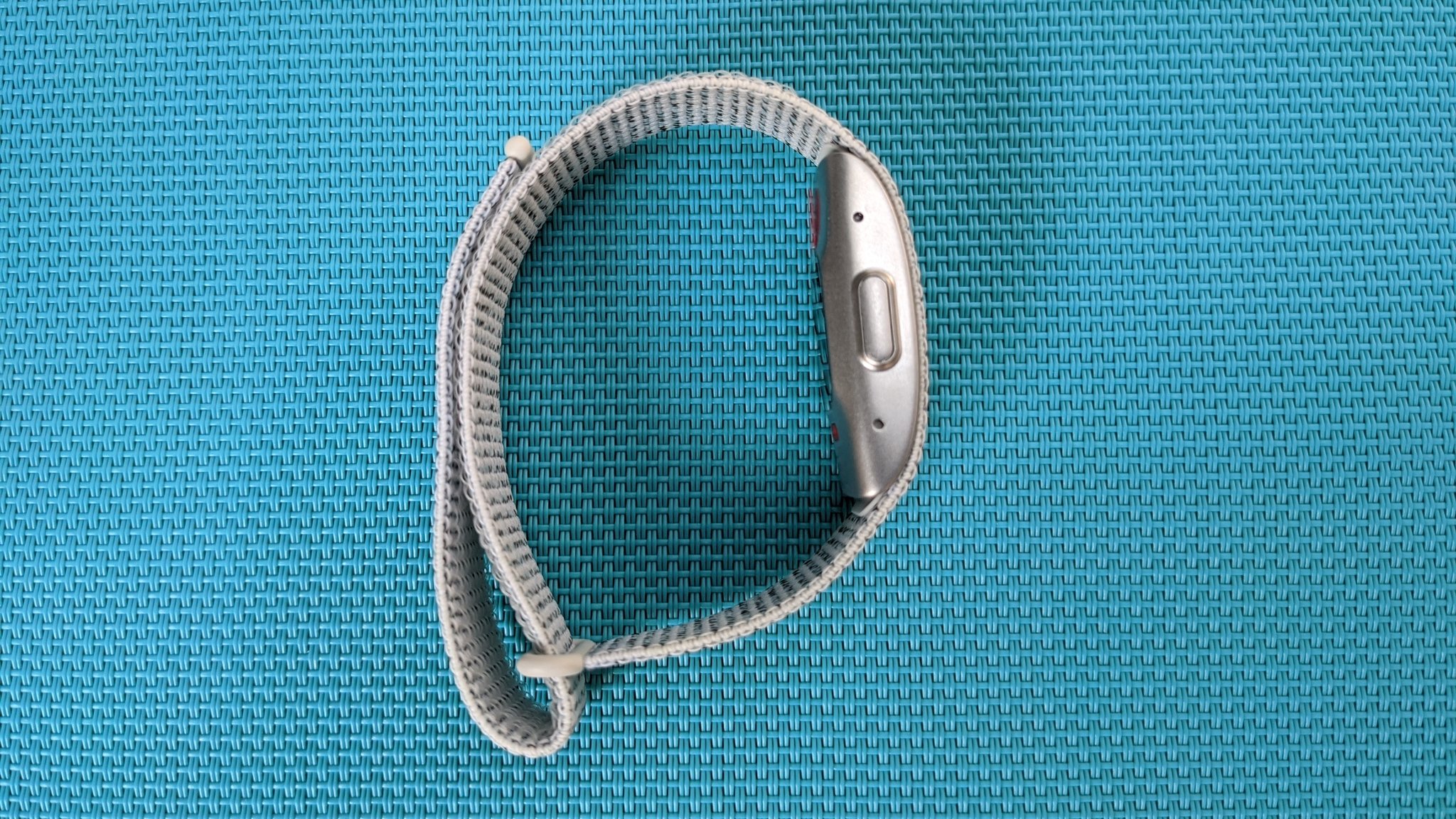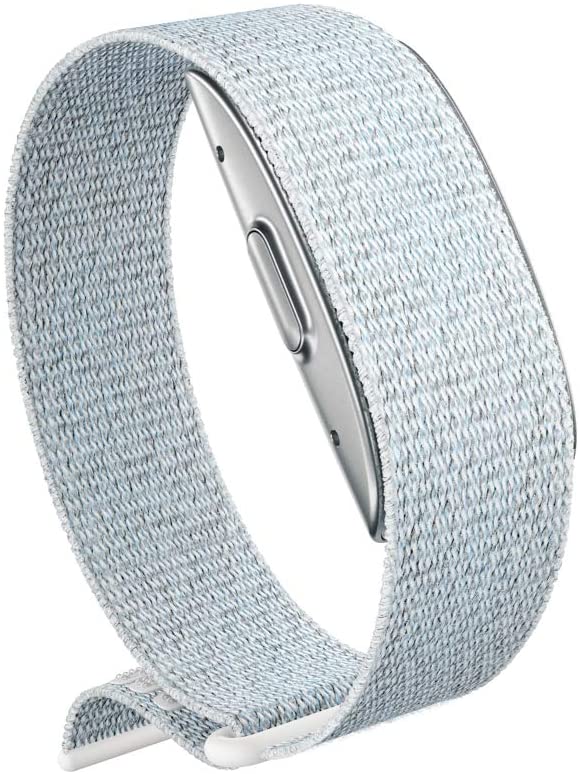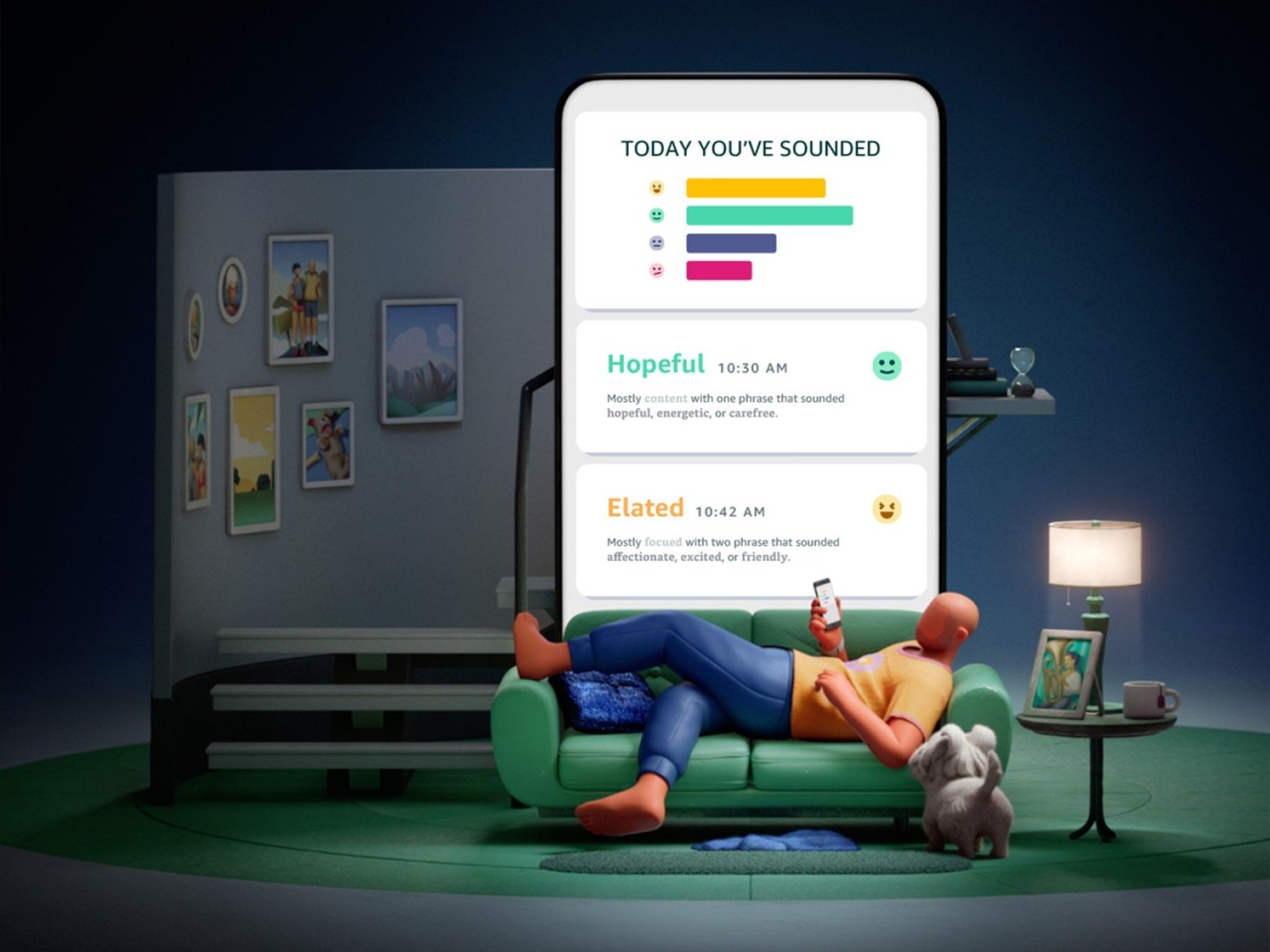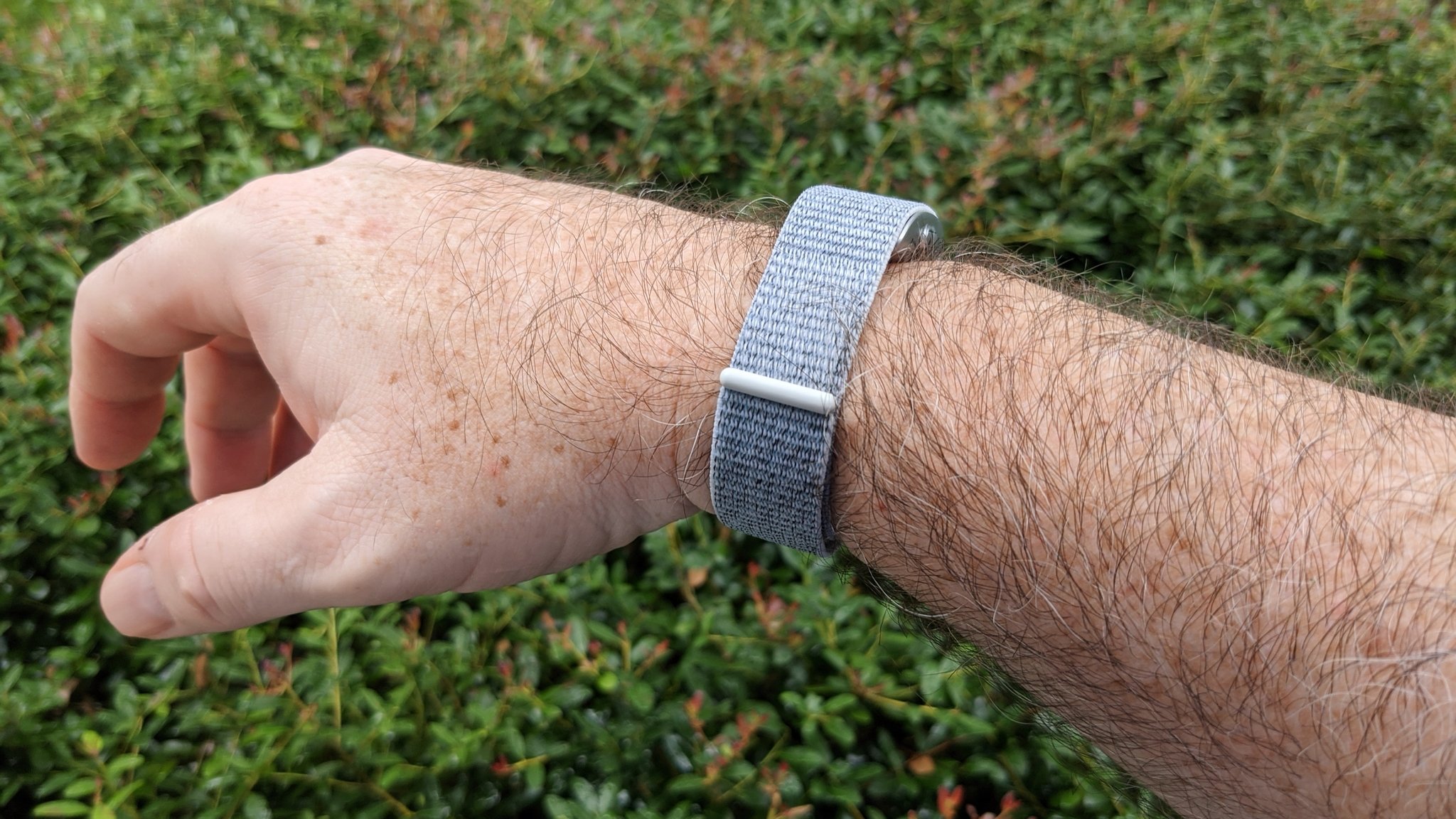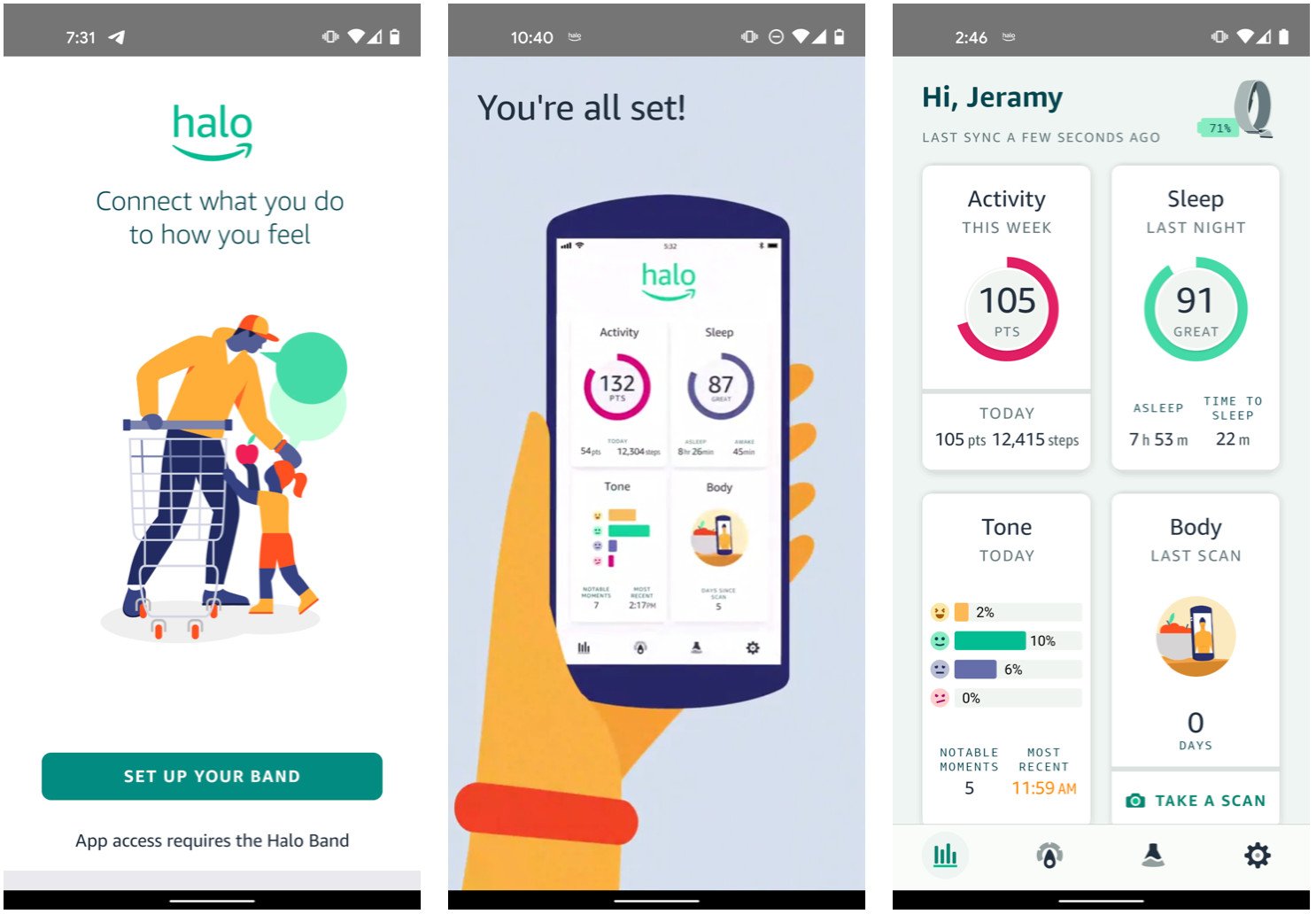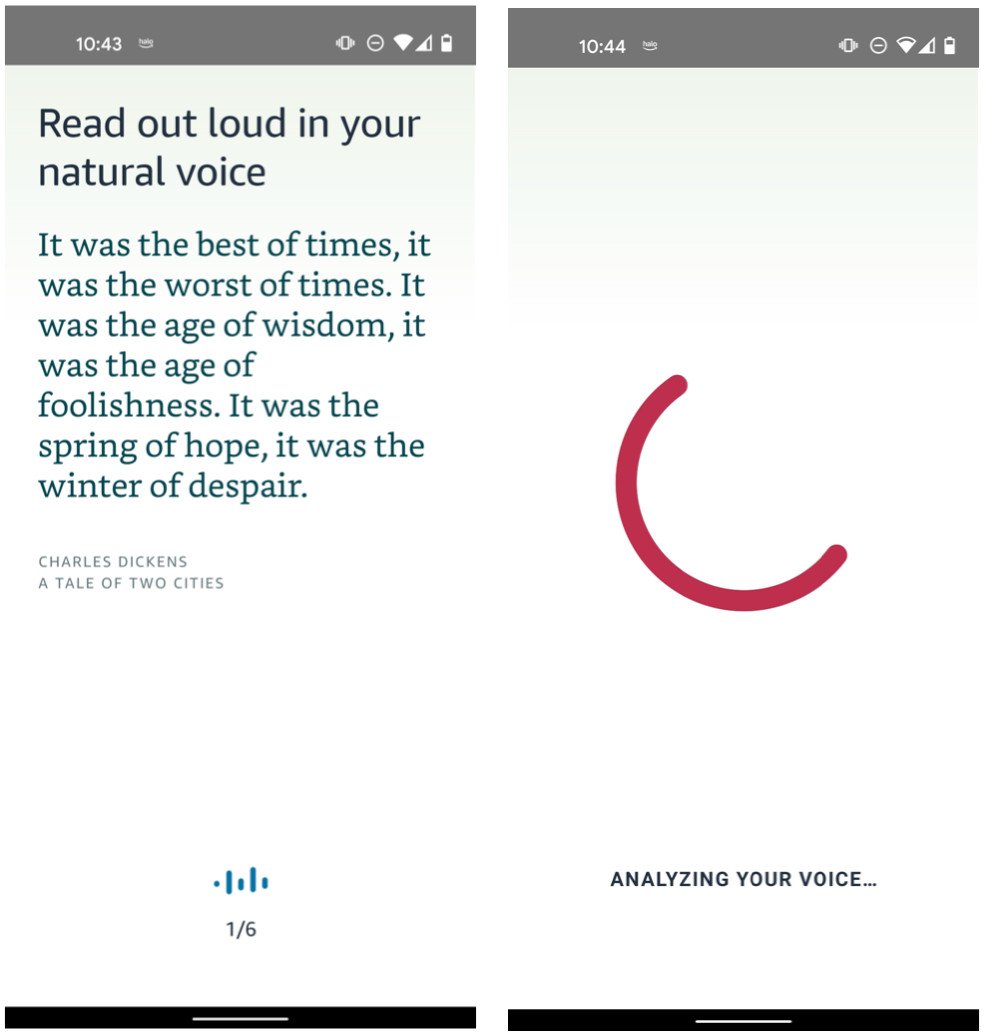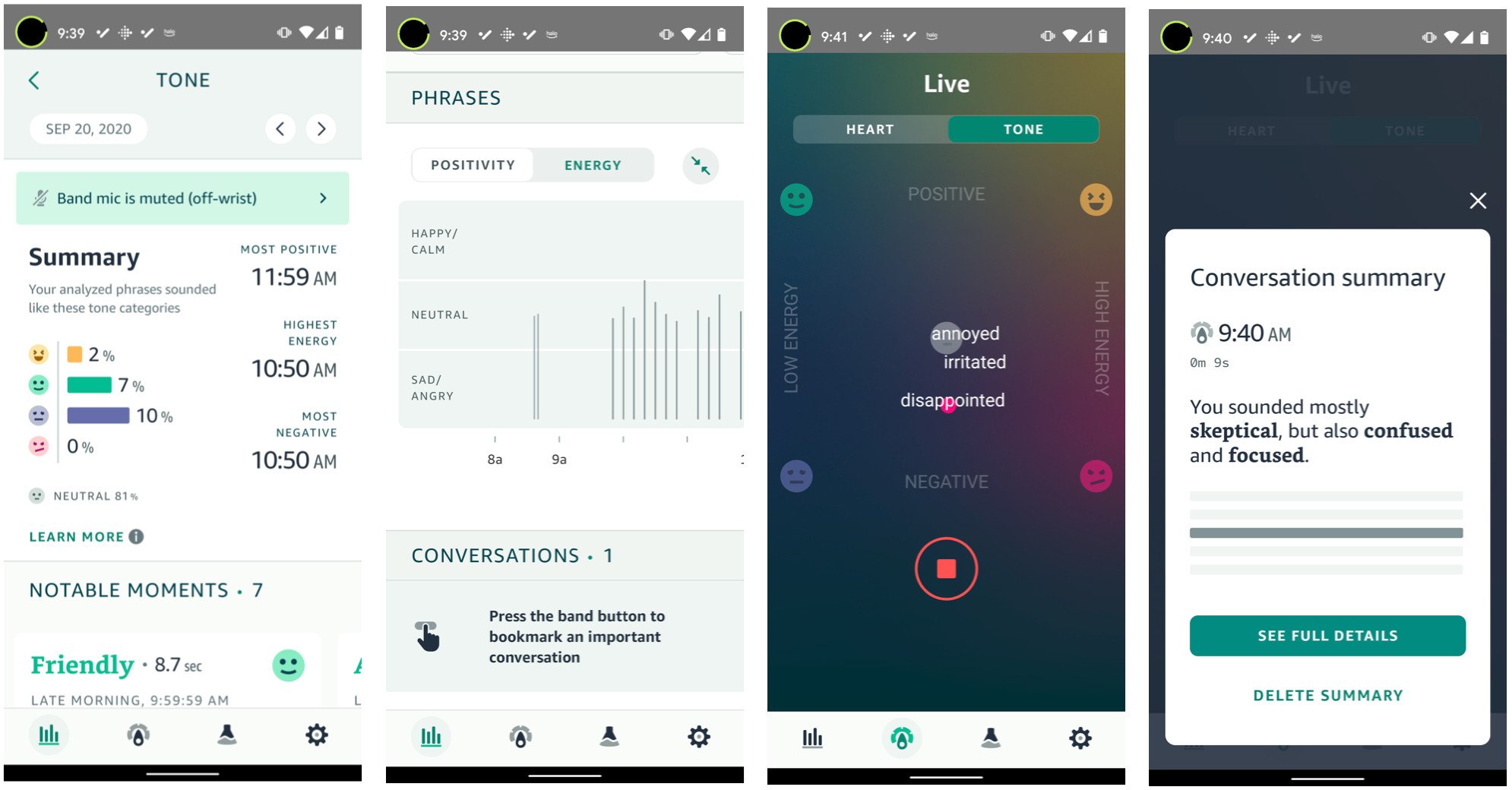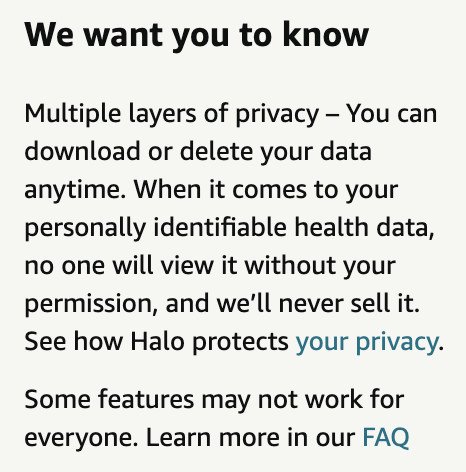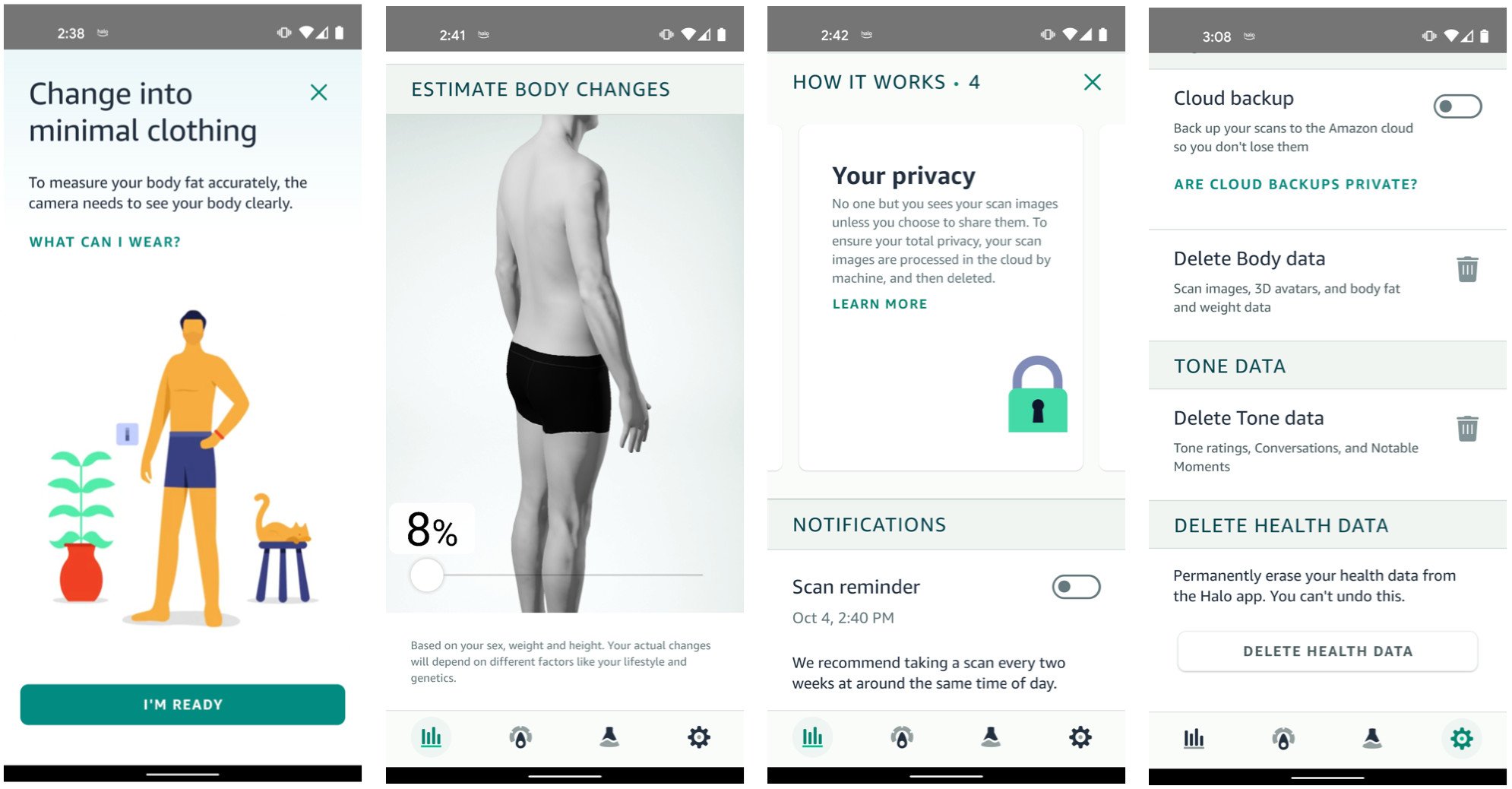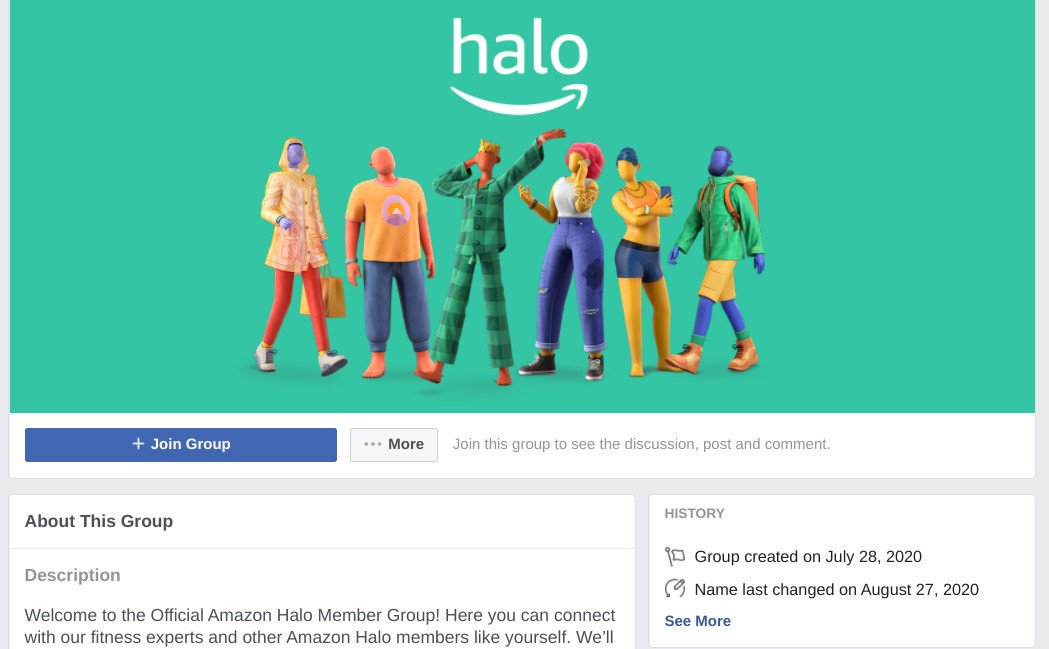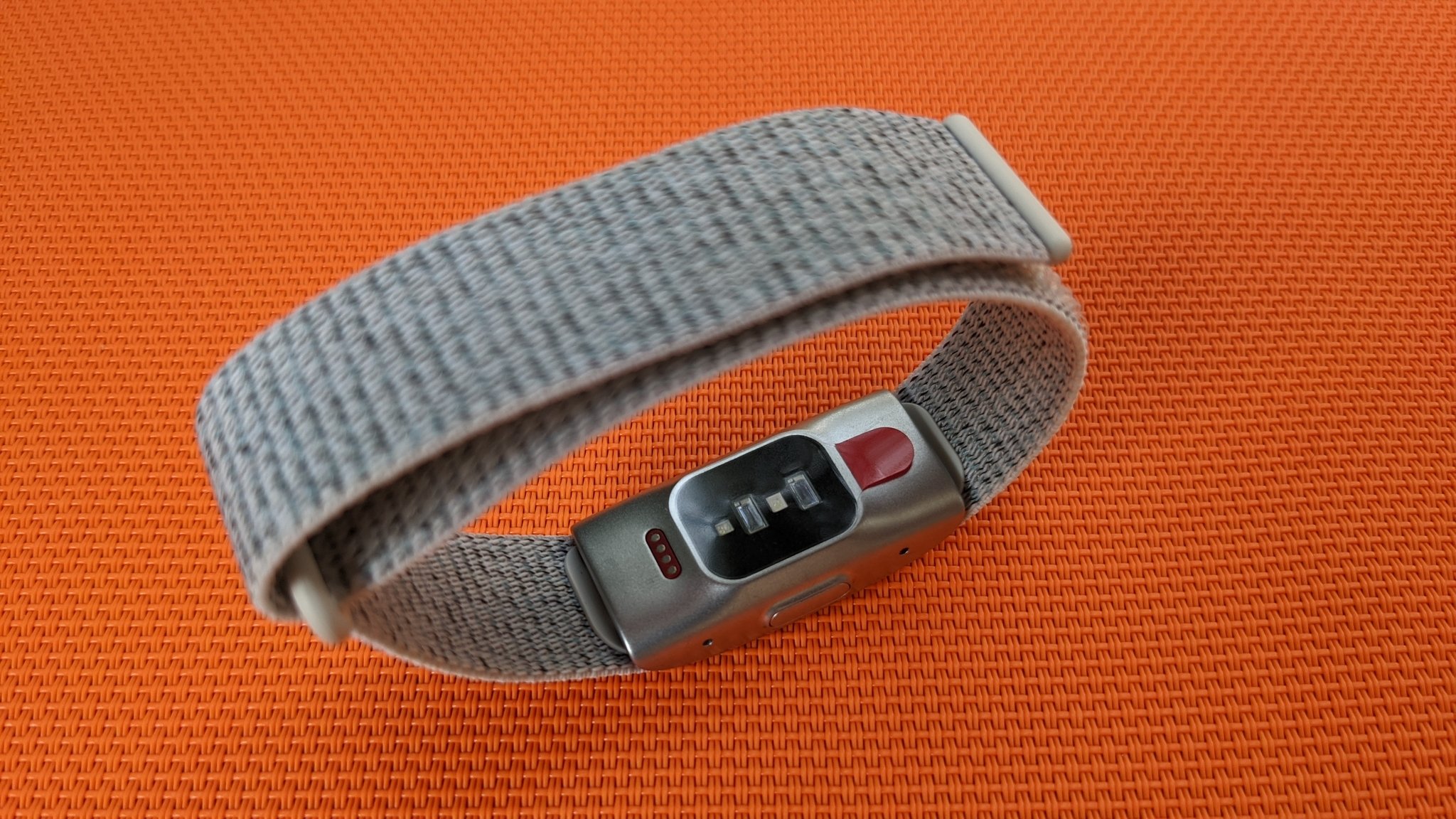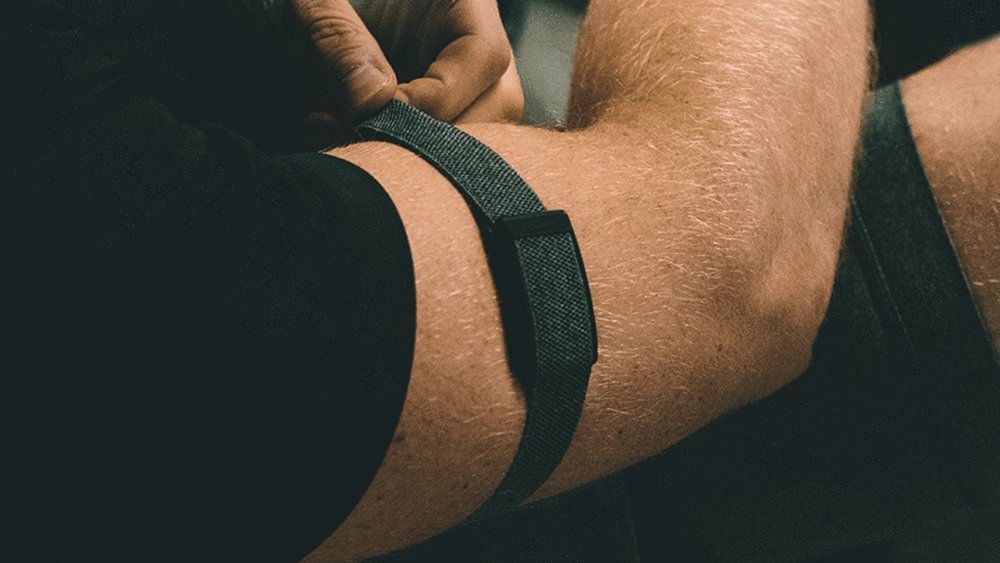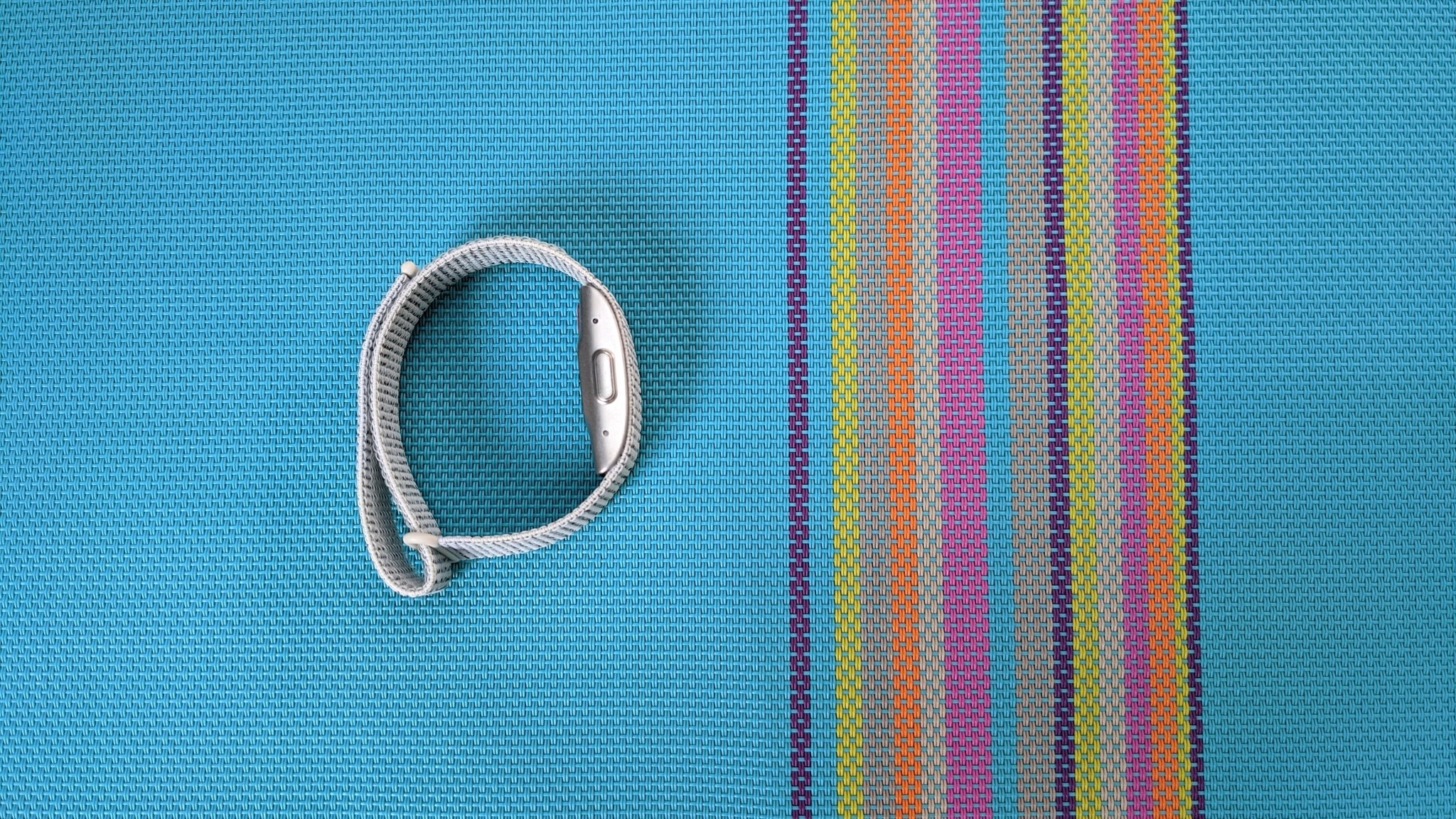Just how much do you want to know about yourself?
In late 2020, Amazon surprised us all with an intriguing product drop in the form of the Amazon Halo band, a holistic fitness wearable that has some fairly ambitious capabilities hidden in a pretty non-descript, understated wrist strap.
Like every other fitness tracker on the market today, the Amazon Halo has sensors and software to track your steps, heart rate, and sleep, and it can even analyze your overall activity levels. There is a Halo subscription plan that provides access to guided workouts, training plans, and enhanced health metrics similar to what Fitbit Premium offers. It is $3.99/month, but the device comes with a free six-month trial, just like Fitbit's latest wearables.
What's more interesting about the Halo are its voice tone and body composition analysis capabilities. Amazon touts how secure this personal data is on its platform, but you will likely either be fascinated by these new features or be terrified by them.
Amazon first introduced the Halo through what it described as an Early Access program. In other words, you initially had to express your interest in ordering the band from Amazon (for a low introductory price of $65), and if Amazon deemed you worthy, you would then receive an invitation to purchase it. This is a formula that the company has used in the past with devices like the orginal Echo speaker, the Echo Auto, and Day 1 products like the Echo Frames and Echo Loop, and it has worked well to get people like me, rabid early adopters, to beta test these products.
I spent about a week wearing the Halo and testing out its baseline and premium features, and I have to say that I've never come away more conflicted about a review. On the one hand (or wrist?), Amazon gets so much right here, and I genuinely applaud it for its innovation. On the other hand, I have serious doubts about whether I should wear it beyond the review period.
So, where did I ultimately land on the Amazon Halo, and do I think you should try to buy one? I'll get to that, but first, let's go over all that this band can do.
Amazon Halo
Bottom line: If you're serious about getting a better understanding of your physical, mental, and emotional wellbeing, the Amazon Halo just might be the perfect holistic wearable for you. From improving communication to analyzing your body for important health metrics, it's as comprehensive as it is simple.
The Good
- Comfortable and stylish straps
- Excellent app experience and user interface
- Basic fitness tracking and impressive premium features
- No unnecessary distractions
- The Tone and Body Composition features work remarkably well
The Bad
- Battery life is only two days with Tone enabled
- Tone and Body Composition features may feel too intrusive for some
$100 at Amazon $100 at Best Buy
Amazon Halo: Price & release date
The Amazon Halo fitness band was announced in August 2020, and shortly thereafter it was made available for an early release price of $65. Amazon then rolled it out to the general public for purchase in December 2020 for a retail price of $100. The device comes with a free six month trial for the Halo membership that includes the tone analysis, body composition, additional health metrics and analysis, and guided workouts and meditation sessions.
Simple setup, comfortable fit, and innovative health features
Amazon Halo What I like
In this age of the best smartwatches, I've remained solid in my commitment to and appreciation for the basic fitness band. And as fitness bands go, they don't get much more basic looking than the Amazon Halo.
As with other Amazon devices, the Halo was extremely easy to set up, and I found the onboarding process straightforward and even enjoyable. You first have to make sure your band is charged and that you've downloaded and logged into the Amazon Halo app (available for iOS and Android). Once those tasks are done, you are walked through the setup process and Halo band's features by a series of charming illustrations and animations (if you haven't watched the videos for the Halo band, you should).
There is no screen to display your fitness stats, notifications, or even the time, which took a bit of getting used to for me at first. Amazon pitches this lack of display as a feature, though, saying that it has been designed to be "distraction-free." I was a bit skeptical of this as a selling point at first, but then I grew to appreciate not having notifications or even the time vying for my attention.
I came to appreciate the distraction-free nature of the display-less Halo
The Halo ships with a polyester/nylon/spandex band similar to what you might see on a Fitbit or Apple Watch, and the band is available in several different sizes and colors (I opted for the large silver version), though there are other sport options available, too.
The Halo was able to fade into the background and just do its thing, and there were large portions of the day where I completely forgot that I even had it on. That is especially remarkable because I wore it on my dominant (right) wrist, opposite the Fitbit Charge 3 that I wear every day. Yes, this was partially because I didn't want to lose out on my ongoing Fitbit competitions, but it was mainly so that I could compare the Halo's accuracy in heart-rate and sleep monitoring and step tracking to my Fitbit (more on that in a bit). I think this type of band could be perfect for the minimalist who doesn't care about seeing their fitness stats constantly on display, or the person who really loves their traditional, analog watch but also wants to have the benefit of continuous health tracking on the other wrist.
The fit, finish, and basic functionality of the Halo isn't anything special, and you could easily find some or all of those features on another fitness tracker. What sets this device apart are two features that Amazon hopes will help you really get to know your body better, have a better grasp on your physical, emotional, and mental wellbeing, and give you some tools and suggestions to make any improvements that you might feel necessary.
The first holistic health feature that Amazon wants you to take advantage of is what it is calling Tone, and yes, it's what it sounds like. With Tone enabled, the Halo will take periodic scans of your speech patterns throughout the day and provide an analysis of them for your review within the app. The band can tell you with remarkable accuracy if your side of the conversation sounded irritated, happy, sad, etc. The process to set up the Tone feature was quite interesting and similar to how you get Alexa, Siri, or the Google Assistant to recognize your voice for the first time. The app asks you to read a series of quotes and captions from famous literary sources to better understand inflections and changes as you speak.
I found the Tone feature to be eerily accurate when it actually picked up my voice (more on that below), but I'm not 100% sure how helpful it is right now. The idea is that you can visualize how you're coming across to others and better understand that perception so that you can make necessary adjustments to how you react with others in future conversations. I can envision applications of this technology that could be beneficial for those with documented communication issues, but it remains to be seen if and how it will be received and used by the masses.
Now when it comes to the basics, I found the Halo to be reasonably competent. The Halo also sports a degree of water-resistance, and is capable of handling up to 5 atm (or 50 meters) of depth. I am not much of a swimmer, but I can attest to the fact that it holds up quite well to the sweaty run and daily shower routine. The heart rate measurements and sleep tracking were spot-on, at least when compared directly to my Fitbit Charge 3. However, the Halo tended to overestimate my step count when compared to the Fitbit. Which one is more accurate? I'm not sure, but there was a definite discrepancy there. Step count accuracy is not that important with the Halo, though, because it wants to track your overall activity level and give you a weekly score that is continuously being adjusted. The default target is 150 points, but you can change that in the app.
You get credit for walking, more credit for jogging, and even more credit for running. The interesting thing about this point system is that you can actually lose points for being sedentary. By being sedentary, I mean being inactive, not necessarily sitting down. It's not clear to me how the Halo addresses those who are in a wheelchair. Overall I really like this approach, as it seems to consider your activity as a whole, not just based on a single metric. It reminds me of the Nike+ Fuelband from back in the day
Don't worry, I'm not going to share my personal body scans with you.
The other main feature of the Halo app and service is its ability to use your smartphone to capture full-body scans. The app uses this data to generate a three-dimensional scan of your body, allowing you to visualize your body composition and measure your body fat percentage. If this freaks you out a bit, you're not alone. Amazon says that its scanning system is ultra-secure. Your scans are only sent to its encrypted cloud long enough to generate the 3D images and then are immediately deleted.
Did I try this feature out? Yes. Am I going to share the results? Absolutely not. I don't think that I would partake in this feature in the future, but I can see how it could be appealing to some. Amazon says that body scans of this caliber can cost tens or hundreds of dollars a pop at clinics or other facilities and that the Halo interpretations are nearly as accurate. Users can take their scans and adjust them to their ideal body composition using a slider in the app. Amazon has tried to address misuse of this feature by those with body dysmorphia issues or those who are not legal adults. However, there is still a lot of concern about how this feature might be abused by users, notwithstanding potential data breaches.
For all the worries about personal voice and body composition data, I do think that Amazon has pretty strong privacy controls and policies in place. As you can see from the screenshots below, users can delete their body scans and voice tone analysis from the cloud at any time, and they can also opt to not store their scans in the cloud but rather on their smartphones. Users can also delete all health data from the Halo app and service with just a tap of a button. Like its Echo speakers, the Halo has a physical mute button on the band as well. Amazon has every reason to keep this data secure, but when it comes to information this personal, there is always going to be concern about it getting out into the wider world.
One area that seems to get overlooked by new entrants into the fitness tracking market is the social component, and I've knocked points from other trackers who have failed to consider this as an important feature. Many people who get a fitness tracker want to see how their activity compares to friends, family, and even strangers. Whether that be in the form of competitions and leaderboards like Fitbit and Apple offer in their apps, or through more universal third-party apps like MapMyRun or Strava, competition can be an important, motivating factor for the success of a wearable and fitness regime.
The Halo does not have its own leaderboard or competitions in the app at this point, nor does it appear to plug into any of these third-party services except for Weight Watchers, but that doesn't mean that there is no social component here. Amazon has created a private Facebook group for Halo owners, where users can connect with other Halo owners and fitness experts to bond and get the most from their Halo experience.
After the Halo became widely available, Amazon has continued to iterate on the features offered with the device and Halo membership service. In March 2021, it added Alexa integration, so you can now ask your favorite voice assistant for your activity score, sleep quality, and body composition. In addition to the hundreds of guided workouts already available through the Halo app, Amazon has added programs from Halle Berry's rē•Spin to SWEAT. And most recently, Halo bands ave gained the ability to analyze your movement health, and suggest exercises to help you improve your posture, gait, and balance.
Innovative features overshadowed by ick factor
Amazon Halo What I don't like
For the most part, I found the Halo to be a perfectly capable and surprisingly comfortable fitness tracker. The experience of wearing the device was similar to any other tracker, and the accompanying app was really well thought out and designed. But it isn't all roses.
For starters, let's talk about battery life and the charging experience. Amazon claims that the Halo can last up to seven days on a single charge, and while that may be technically true, most users won't likely experience that longevity, at least not at first. To its credit, Amazon does say this front and center in the Halo's documentation and on the website, but if you have the Tone feature enabled, then your battery life drops to about two to two-and-a-half days, maximum. That's still better than many popular smartwatches, but it's not great for a tracker. Of course, I understand why the battery gets depleted more quickly with an always-on microphone enabled, but it's something you may want to keep in mind.
Just what you need, another proprietary charging cable to clutter your nightstand.
When it comes to recharging the Halo, Amazon gives you yet another proprietary charging clamp or cradle. If you have had any Fitbit in the past, you know the kind I'm referring to. The charging cradle is well-made and looks fine, but it's just another piece of e-waste cluttering up your desk, drawer, or nightstand.
And speaking of the Tone feature, I found the experience to be a bit inconsistent, not in terms of the accuracy of its results or analysis, but the everyday use of it. I found that the Halo took voice readings very sporadically, and some days I didn't have any results. Sure, you can run a scan manually through the app, but I wanted to see if the device worked as advertised. My theory on why I got inconsistent results was that the processing is done on your smartphone, and there were days where I spent hours sequestered in my office, several rooms away from my Pixel 4a where the Halo app was running. So the lesson here is if you want to get good Tone readings, keep your phone nearby.
I mentioned above how I quickly grew to appreciate the lack of a display on the Halo, and how Amazon touts this as a feature for a more distraction-free lifestyle. While I believe Amazon had good intentions with this design that were both pragmatic (it's cheaper not to include a display) and noble (we spend too much time looking at devices), the more conspiratorial among us could be forgiven for feeling a little on edge here. After all, this device is another microphone on our bodies and in our homes that just sort of fades into the background and out of our perception. If there were a display on this band that gave you visual prompts or notifications of your voice scans, you might react to it differently.
Not that Amazon is hurting for money, but the real economic model here is not in the sale of the hardware, but in the associated subscription service. We've seen this strategy played out time and time again, most recently with Fitbit Premium and Apple Fitness Plus. The Halo+ service is much cheaper than those other options at just $3.99/month, and Amazon does give you the first six months free (something Fitbit is doing right now with its new devices, too). Of course, you don't need to subscribe to access the basic fitness tracking. Still, if you want to take advantage of Tone, Body Composition, or any additional guided workouts and extras, the Halo+ subscription will be required.
I wonder if people will be able to get past the initial "ick" factor of this device.
The biggest reservation that I have about the Halo is just, well, how do I say this... it gives me the heebie-jeebies a bit. Paying for a device and a service that is literally judging how I act and look would take some getting used to, to put it mildly. I can see the potential benefits and use cases, and I admire companies like Amazon and Fitbit for exploring holistic health strategies, but these are still hurdles that I and others will need to get over if a device like this is to succeed.
Amazon Halo The competition
There are so many fitness bands and exercise wearables to which I could compare the Amazon Halo, but there are two specific devices that come to mind if you're considering this device.
The first is the Whoop Strap 3.0 strap and membership experience. At first glance, the Whoop looks almost exactly like the Halo band, and I do not doubt that Amazon drew inspiration for its product and service from this device. Whoop has been around for several years and has already received wide acclaim and support from the wellness industry. It's even worn and endorsed by professional athletes like Super Bowl MVP Patrick Mahomes and champion PGA golfer Justin Thomas. The device can be worn with different straps across your wrist, leg, arm, or body, and is priced based on a $30/month subscription model for the band and accompanying service.
The Fitbit Sense retails for $330 and has some innovative health features of its own. Not only does the smartwatch come with an advanced heart rate monitor, but it packs an FDA-approved SpO2 sensor, an EDA (electrodermal activity) sensor, skin temperature sensor to monitor changes in your skin to look for signs of impending sickness, as well as a built-in ECG monitor. The Sense comes with six months of Fitbit Premium, which you can extend for $9.99/month.
Both of these wearables are more expensive up-front than the Halo, as are their accompanying membership subscriptions. Plus, the Fitbit Sense is a more full-featured smartwatch, which may or may not appeal to someone considering a more minimalistic band or tracker.
Should you buy
You should buy this if ...
You are comfortable in the Amazon ecosystem
If you already have a bunch of Echo speakers, Fire TV devices, and Ring and Eero smart home products in your house, then chances are you are pretty comfortable with your connection to Amazon and its devices.
You want a minimalist tracker
Fitness wearables don't get much simpler looking than the Amazon Halo. This device definitely won't be a distraction in everyday use.
You want a better picture of your overall health
This simple-looking device has some quite powerful features that can help you get a better understanding of your physical, mental, and emotional wellbeing.
You should not buy this if...
You are even the slightest bit paranoid
As I said, I trust Amazon's privacy and security measures and think it is doing the right thing right now in this regard, but I totally get it if you don't, or if you have reservations.
You have severe or diagnosed body dysmorphia issues
While Amazon is trying to prevent those with such issues from using the Body Composition features, if you suffer from body dysmorphia or severe self-image issues, you should probably consult your physician or therapist before even considering ordering this device.
You want smartwatch functionality
If you like to be able to triage notifications, see the temperature and time, or your fitness progress on the fly, you're not going to be happy with this band.
Overall, I came away way more impressed with the Halo than I imagined I would. At its most basic, I found it to be an attractive and comfortable basic fitness tracker that I could actually envision myself wearing. At its most complicated, it pushes up against the limits of wrist-based holistic health tracking and societal norms for privacy and intimacy.
My recommendation is that if you are even the slightest bit interested in a new fitness band or this tracker specifically, then go ahead and request early access to purchase the Halo. The initial price is quite affordable, and you can always opt-out of the Tone and Body Composition features and analysis. Alternatively, you can opt back into them at any time, and the monthly fee to access Halo+ is the most affordable I've seen from similar bands.
The bottom line is this: if you really want to know about yourself and your health and habits, the Halo is an interesting device that can provide a ton of insight that is difficult to find anywhere else right now, especially at this price point.
A crowning achievement
Amazon Halo
$100 at Amazon $100 at Best Buy
Simple and powerful
The Amazon Halo band may look like a simple device, but hidden inside are powerful features capable of providing in-depth insights to guide you on your overall fitness journey.
Review Changelog, June 2021
This article was originally published in September 2020. It was updated in June 2021 with the following changes:
- Added price and release date section and updated with current pricing.
- Included updated Halo membership features and information like Halle Berry guided workous, movement health analysis, and Alexa integration.
Source: androidcentral
